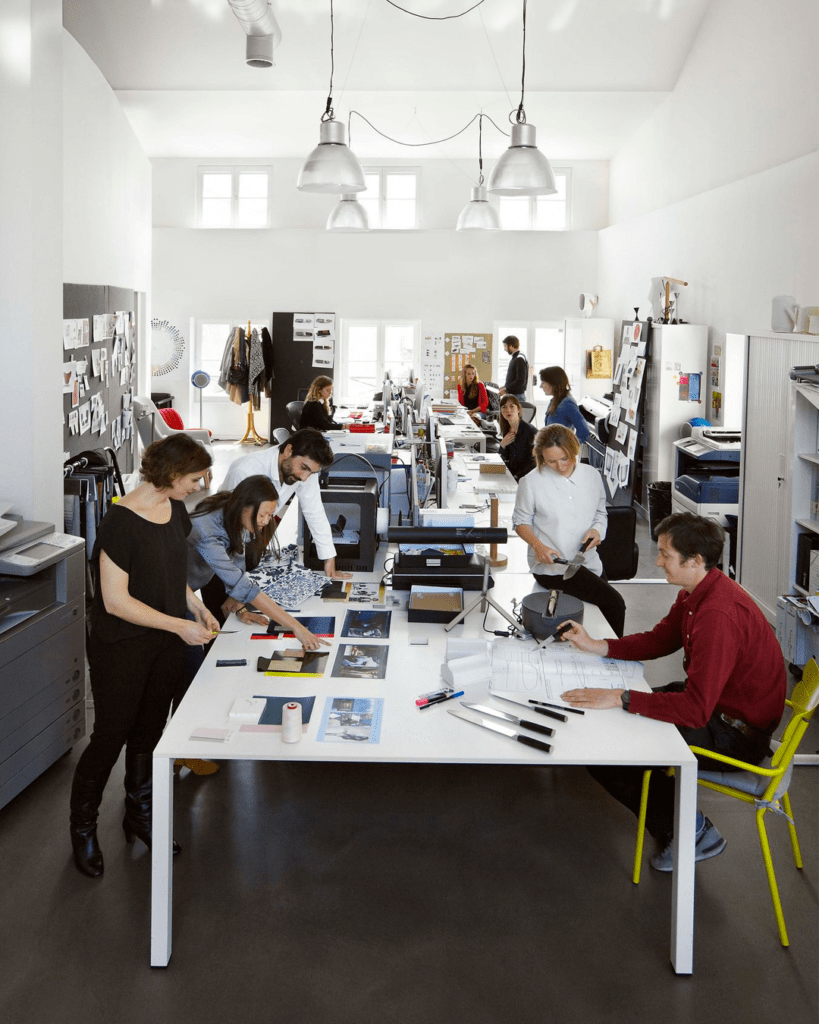REIMAGINING WORKSPACES: EMBRACING THE FUTURE OF WORK IN 2023
Table of Contents:
- Introduction
- The Evolving Nature of Work
- Trends Shaping Workspaces in 2023 Well-being and Collaboration
- The Role of Construction in Shaping Future Workspaces Prioritizing Technology Infrastructure
- Case Studies: Innovative Workspaces of 2023
- Challenges and Considerations for the Future
- Conclusion: Embracing the Future of Workspaces
Introduction:
The way we work is continuously evolving, and as we step into 2023, new trends and technologies are reshaping the work environment. This blog post explores the future of workspaces, highlighting what to expect in 2023 and how construction can prioritize these needs to create optimal work environments.
The Evolving Nature of Work: The traditional 9-to-5 office setup is giving way to more flexible work arrangements, driven by technological advancements and changing employee expectations. Remote work and hybrid models are becoming increasingly prevalent, transforming the way we perceive and utilize workspaces.
Trends Shaping Workspaces in 2023: In this section, we delve into the key trends shaping workspaces in 2023. These include the rise of remote and hybrid work, the need for flexible and agile spaces, the integration of technology, and the focus on employee well-being and collaboration.
The Role of Construction in Shaping Future Workspaces: Construction plays a vital role in creating workspaces that meet the evolving needs of the workforce. This section explores how construction should prioritize these needs by designing for flexibility, embracing sustainable practices, prioritizing technology infrastructure, and fostering employee well-being and productivity.
Case Studies: Innovative Workspaces of 2023: Examining real-world examples, this section showcases innovative workspaces that embody the future of work in 2023. It includes tech-integrated smart offices, collaborative co-working spaces, and remote work hubs that cater to the changing dynamics of work.
Challenges and Considerations for the Future: The future of workspaces also comes with challenges and considerations that need to be addressed. This section discusses topics such as privacy and data security, work-life balance, and creating inclusive and accessible workspaces to ensure a harmonious and productive work environment.
Conclusion: Embracing the Future of Workspaces: In conclusion, this blog post emphasizes the importance of embracing the future of workspaces in 2023. By understanding the evolving nature of work, prioritizing construction efforts, and accommodating changing needs, organizations can create work environments that foster productivity, collaboration, and employee well-being.
The Evolving Nature of Work

The nature of work has been undergoing a significant transformation in recent years, and this evolution continues to shape the way we perceive and utilize workspaces. In 2023, we can expect several key trends to define the future of work and influence the design and functionality of work environments.
Remote and Hybrid Work: One of the most prominent shifts in the work landscape is the rise of remote and hybrid work models. Advances in technology have made it easier than ever for employees to work from anywhere, blurring the boundaries between traditional office spaces and alternative work settings. In 2023, we can expect a greater emphasis on creating workspaces that support and facilitate remote collaboration, with flexible arrangements that accommodate both in-person and virtual interactions.
Flexible and Agile Spaces: As organizations recognize the benefits of adaptable work environments, there is a growing demand for flexible and agile spaces. Workspaces need to be designed to accommodate various work styles, preferences, and activities. This includes providing a mix of private and open areas, incorporating modular furniture and layouts, and creating multipurpose spaces that can be easily reconfigured to meet evolving needs.
Technology Integration: The integration of technology into workspaces is becoming increasingly critical. In 2023, we can expect a greater reliance on smart devices, Internet of Things (IoT) connectivity, and automation to enhance productivity and streamline workflows. Workspaces will need to prioritize robust technology infrastructure, providing seamless connectivity, video conferencing capabilities, and collaborative tools to support remote and hybrid work.
Employee Well-being and Collaboration: The well-being of employees and fostering collaboration are central to the future of workspaces. Work environments should prioritize features that promote physical and mental health, such as access to natural light, ergonomic furniture, and spaces dedicated to relaxation and rejuvenation. Additionally, collaborative areas that facilitate teamwork, brainstorming, and social interactions will play a crucial role in enhancing creativity, innovation, and a sense of community.
By embracing these evolving trends, organizations can create workspaces that cater to the changing needs and expectations of the workforce. However, achieving these goals requires a strategic approach in the construction industry to prioritize and adapt to these emerging requirements. In the following sections, we will explore how the construction sector can play a vital role in shaping the future of workspaces by embracing flexibility, sustainability, technology integration, and employee-centric design.
Trends Shaping Workspaces in 2023

In 2023, several key trends are shaping the design and functionality of workspaces. These trends reflect the evolving needs and expectations of the modern workforce. Let’s explore some of the significant trends that are influencing the future of workspaces:
Remote and Hybrid Work: The COVID-19 pandemic accelerated the adoption of remote work, and it has become a mainstream practice in many industries. In 2023, remote work and hybrid models, combining both remote and in-person work, will continue to shape workspaces. This trend emphasizes the need for technology-enabled work environments that facilitate seamless communication and collaboration between remote and on-site employees.
Flexible and Agile Spaces: The traditional office layout is giving way to flexible and agile workspaces. These spaces prioritize adaptability, allowing employees to choose from a variety of settings based on their needs and tasks. Flexible workspaces may include open areas for collaboration, quiet zones for focused work, shared workstations, and private pods or booths. Such spaces promote employee autonomy and provide an environment that fosters productivity and creativity.
Technology Integration: Technology plays a central role in the future of workspaces. Integration of digital tools, collaborative platforms, and smart devices enables seamless communication and connectivity. In 2023, workspaces will increasingly incorporate technologies such as video conferencing systems, virtual reality (VR) and augmented reality (AR) tools, IoT devices, and cloud-based platforms to enhance collaboration and productivity.
Employee Well-being and Collaboration: Workspaces are becoming more focused on promoting employee well-being and collaboration. Design elements that prioritize natural light, biophilic elements, and ergonomic furniture contribute to a healthier and more comfortable work environment. Collaboration areas such as meeting rooms, brainstorming zones, and social spaces encourage teamwork and innovation.
Sustainability and Environmental Responsibility: The importance of sustainable practices and environmental responsibility is growing in the construction industry. Workspaces are being designed with energy-efficient lighting systems, recycling stations, green building materials, and sustainable construction techniques. Creating eco-friendly work environments aligns with the values of organizations and employees while contributing to a greener future.
Wellness and Mental Health Support: In recognition of the impact of work on mental health, workspaces are being designed to support employee well-being. Dedicated spaces for relaxation, meditation, and wellness activities are being integrated into the workplace. Additionally, companies are implementing policies and programs that prioritize mental health support, such as counseling services and mindfulness initiatives.
These trends are reshaping workspaces to create environments that promote flexibility, collaboration, well-being, and productivity. Construction professionals must adapt to these trends by designing and constructing spaces that can accommodate the changing needs and expectations of the modern workforce. In the next section, we will explore how the construction industry can prioritize these needs to create workspaces that embrace the future of work.
The Role of Construction in Shaping Future Workspaces
The construction industry plays a crucial role in shaping the future of workspaces by creating environments that meet the evolving needs of the workforce. As work patterns change and new trends emerge, construction professionals must prioritize certain aspects to ensure that workspaces are designed and built to optimize productivity, collaboration, and employee well-being. Here are key areas where construction should focus to shape future workspaces:
Designing for Flexibility and Adaptability: Workspaces need to be designed with flexibility in mind. Construction professionals should prioritize adaptable layouts, movable partitions, and modular furniture that can be easily reconfigured to accommodate changing needs. Flexible spaces can support remote work, collaborative activities, and individual focus, allowing employees to personalize their work environment.
Embracing Sustainable Practices: Sustainability is increasingly important in workspace design and construction. Employing green building materials, incorporating energy-efficient systems, and integrating renewable energy sources reduce the environmental impact of workspaces. Construction professionals should prioritize sustainable practices, such as using recycled materials, optimizing energy consumption, and implementing waste reduction strategies.
Prioritizing Technology Infrastructure: Seamless integration of technology is vital for future workspaces. Construction should focus on robust technology infrastructure, including high-speed internet connectivity, smart building systems, and adaptable wiring for power and data. Incorporating technologies like video conferencing systems, collaboration tools, and IoT devices ensures workspaces are equipped to support remote work, virtual meetings, and efficient communication.
Fostering Employee Well-being and Productivity: The design and construction of workspaces should prioritize employee well-being and productivity. Construction professionals can incorporate elements such as natural light, proper ventilation, ergonomic furniture, and acoustic insulation to create a comfortable and healthy work environment. Designing dedicated spaces for relaxation, breakout areas, and wellness facilities can promote employee well-being and support mental health.
By considering these factors, the construction industry can actively contribute to shaping workspaces that align with the future of work. Collaborating with architects, designers, and technology experts can facilitate the integration of innovative solutions and ensure that workspaces are adaptable, sustainable, and supportive of the changing needs of employees.
In the next section, we will explore case studies of innovative workspaces in 2023 that exemplify the principles discussed above. These examples will provide insights into how construction and design can converge to create work environments that embody the future of work.
Case Studies: Innovative Workspaces of 2023
Case Study 1: Tech-Integrated Smart Offices
Company X, a leading technology firm, embraced the future of work by creating a smart office that integrates advanced technologies to enhance productivity and collaboration. The construction team collaborated closely with architects and technology experts to design and build this innovative workspace.
Key features of the smart office include:
IoT Integration: Sensors embedded throughout the office collect data on occupancy, temperature, and lighting levels, allowing for real-time adjustments to optimize comfort and energy efficiency.
Interactive Workstations: Each workstation is equipped with adjustable height desks, personalized temperature and lighting controls, and wireless charging stations, empowering employees to customize their work environment.
AI-Powered Meeting Rooms: Meeting rooms are equipped with AI assistants that automate tasks such as scheduling, note-taking, and transcription, streamlining collaboration and improving meeting efficiency.
Virtual Collaboration Spaces: VR and AR technologies are integrated into dedicated collaboration areas, enabling remote team members to participate in virtual meetings, brainstorming sessions, and design reviews, fostering seamless remote collaboration.
Case Study 2: Co-working Spaces for Collaboration
In response to the rise of remote work and the need for flexible workspaces, Company Y, a progressive startup incubator, developed a co-working space that encourages collaboration and networking among individuals from different companies and industries.
Key features of the co-working space include:
Open and Collaborative Layout: The space is designed with open floor plans, communal worktables, and comfortable seating areas to encourage interaction, idea sharing, and spontaneous collaboration among members.
Versatile Meeting Pods: The co-working space offers modular meeting pods that can be easily configured for various purposes, such as brainstorming sessions, team meetings, or private phone calls, providing flexibility and privacy when needed.
Community Building Initiatives: The construction team incorporated communal areas like shared kitchens, lounges, and event spaces to foster a sense of community. Regular networking events, workshops, and seminars are organized to facilitate connections and knowledge exchange.
Case Study 3: Remote Work Hubs
Recognizing the growing demand for remote work, Company Z, a multinational corporation, established remote work hubs strategically located in urban centers. These hubs provide employees with a dedicated workspace closer to their homes, reducing commuting time and promoting work-life balance.
Key features of the remote work hubs include:
Technology Infrastructure: The hubs are equipped with high-speed internet, video conferencing facilities, and collaborative tools to support seamless remote work and virtual meetings.
Agile Workstations: The workspaces offer a variety of flexible workstations, including standing desks, quiet zones, and collaborative areas, accommodating different work preferences and tasks.
On-site Support Services: To cater to employees’ needs, the hubs provide amenities such as on-site IT support, meeting rooms, printing facilities, and refreshment areas, ensuring a productive and comfortable work environment.
These case studies exemplify how construction professionals can collaborate with design and technology experts to create innovative workspaces that embrace the future of work. By prioritizing flexibility, technology integration, collaboration, and employee well-being, construction can shape work environments that cater to the diverse needs and expectations of the modern workforce. In the next section, we will discuss the challenges and considerations that arise with the future of workspaces.
Challenges and Considerations for the Future
As we envision the future of workspaces, it is essential to consider the challenges and address the potential considerations that arise. Adapting to the changing dynamics of work requires careful planning and consideration of various factors. Here are some key challenges and considerations to keep in mind:
Privacy and Data Security: With the increasing integration of technology in workspaces, safeguarding privacy and data security becomes paramount. Construction professionals must work closely with IT and cybersecurity experts to ensure that data networks are secure, and sensitive information is protected. Robust encryption measures, secure access controls, and regular security audits should be implemented to mitigate risks.
Work-Life Balance: While remote and flexible work arrangements offer numerous benefits, they can also blur the boundaries between work and personal life. Creating workspaces that promote work-life balance is crucial. Construction professionals should design environments that encourage employees to disconnect and establish clear boundaries between work and personal time. Incorporating dedicated relaxation areas, outdoor spaces, and promoting flexible schedules can contribute to a healthier work-life balance.
Inclusive and Accessible Workspaces: Workspaces should be designed to be inclusive and accessible to individuals of all abilities. Construction professionals must prioritize accessibility features such as ramps, elevators, adjustable desks, and assistive technologies. Incorporating universal design principles ensures that workspaces accommodate diverse needs, promoting inclusivity and equality.
Sustainability and Environmental Impact: As we build for the future, minimizing the environmental impact of workspaces is crucial. Construction professionals should prioritize sustainable practices, including using energy-efficient materials, implementing renewable energy sources, and optimizing waste management systems. Designing workspaces with green building certifications, such as LEED or BREEAM, can contribute to a more sustainable future.
Psychological and Emotional Well-being: Creating workspaces that prioritize employee well-being requires a holistic approach. Construction professionals should consider factors such as indoor air quality, acoustics, access to natural light, and biophilic elements to enhance psychological and emotional well-being. Incorporating spaces for relaxation, meditation, and physical activity can promote mental health and reduce stress levels.
By addressing these challenges and considerations, construction professionals can create workspaces that are inclusive, sustainable, secure, and supportive of employees’ well-being. By embracing the future of workspaces while keeping these considerations in mind, organizations can cultivate productive and engaging work environments that meet the diverse needs of their workforce.
In the concluding section, we will summarize the key insights and highlight the importance of embracing the future of workspaces in 2023.
Conclusion: Embracing the Future of Workspaces
As we reach the conclusion of our blog post, “Embracing the Future of Workspaces in 2023,” we have explored the transformative trends shaping workspaces, the role of construction in shaping these environments, innovative case studies, and the challenges and considerations that arise with the future of workspaces. The way we work is evolving rapidly, and workspaces must adapt to meet the changing needs and expectations of the modern workforce.
In 2023, workspaces are embracing remote and hybrid work models, fostering flexibility and adaptability, integrating technology, prioritizing employee well-being and collaboration, and embracing sustainability. Construction professionals play a vital role in shaping the future of workspaces by designing and building environments that align with these trends.
Through case studies, we have witnessed the power of innovative workspaces that embrace smart technologies, collaboration, and flexibility. Tech-integrated smart offices, co-working spaces for collaboration, and remote work hubs exemplify the possibilities for creating work environments that optimize productivity, connectivity, and well-being.
However, challenges and considerations such as privacy and data security, work-life balance, inclusivity, sustainability, and psychological well-being should not be overlooked. Construction professionals must address these aspects when designing and constructing workspaces to ensure they are safe, inclusive, sustainable, and supportive of employee needs.
By embracing the future of workspaces, organizations can foster a culture of innovation, collaboration, and well-being. Workspaces that prioritize flexibility, technology integration, employee well-being, and sustainability will attract and retain top talent, enhance productivity, and position businesses for long-term success.
As we move forward into the future, the construction industry must continue to adapt and evolve, collaborating with architects, designers, and technology experts to create workspaces that embrace the changing dynamics of work. By prioritizing the needs of the workforce and the potential of innovative design and construction practices, we can shape workspaces that empower employees, drive innovation, and pave the way for a truly transformative work experience.
Embrace the future of workspaces, and embark on the journey to create dynamic, inclusive, and inspiring work environments that unleash the full potential of the modern workforce in 2023 and beyond.



